
Drawstring pants are pants that have a drawstring at the waist that allows for an adjustable fit. Often the pants are made of lightweight, breathable material and are popular for their ease of wear and versatility. [1]

Drawstring pants are pants that have a drawstring at the waist that allows for an adjustable fit. Often the pants are made of lightweight, breathable material and are popular for their ease of wear and versatility. [1]
Drawstring pants are used with patient gowns or scrubs. They are also used in traditional clothing like the dashiki, kaftan, or the Daura-Suruwal. They are also part of the Brazilian jiu-jitsu gi.

A quiver is a container for holding arrows or bolts. It can be carried on an archer's body, the bow, or the ground, depending on the type of shooting and the archer's personal preference. Quivers were traditionally made of leather, wood, furs, and other natural materials, but are now often made of metal or plastic.
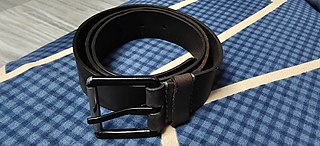
A belt is a flexible band or strap, typically made of leather, plastic, or heavy cloth, worn around the natural waist or near it. The ends of a belt are free; and a buckle forms the belt into a loop by securing one end to another part of the belt, at or near the other end. Often, the resulting loop is smaller than the hips. Belts come in many lengths because of the variety in waist sizes, and most belts can be adjusted at the buckle to suit the wearer's waist.

The Army Combat Uniform (ACU) is the current combat uniform worn by the United States Army, U.S. Air Force, U.S. Space Force and some elements of the U.S. Coast Guard. Within the Air Force and Space Force, it is referred to as the OCP Uniform, rather than the Army Combat Uniform.

A bed sheet is a rectangular piece of cloth used either singly or in a pair as bedding, which is larger in length and width than a mattress, and which is placed immediately above a mattress or bed, but below blankets and other bedding. A bottom sheet is laid above the mattress, and may be either a flat sheet or a fitted sheet. A top sheet, in the many countries where they are used, is a flat sheet, which is placed above a bottom sheet and below other bedding.
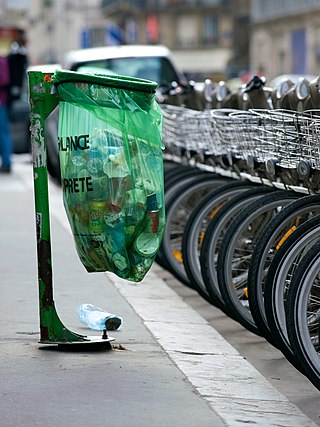
A bin bag, rubbish bag, garbage bag, bin liner, trash bag or refuse sack is a disposable receptable for solid waste. These bags are useful to line the insides of waste containers to prevent the insides of the container from becoming coated in waste material. Most bags today are made out of plastic, and are typically black, white, or green in color.

A stuff sack is a type of drawstring bag, usually used for storing camping items. Stuff sacks are commonly used for the storage of sleeping bags, which are then stuffed into the bag, rather than rolled or folded. Stuff sacks may also be used as general containers to collect many small items together.

SpongeBob SquarePants is an American animated television series created by marine science educator and animator Stephen Hillenburg that first aired on Nickelodeon as a sneak peek after the 1999 Kids' Choice Awards on May 1, 1999, and officially premiered on July 17, 1999. It chronicles the adventures of the title character and his aquatic friends in the underwater city of Bikini Bottom.

Braccae is the Latin term for "trousers", and in this context is today used to refer to a style of trousers made from wool. According to the Romans, this style of clothing originated from the Gauls.

Sirwal, also sherwal, saroual, seroual, sarouel or serouel (Arabic: سِرْوَال, also known, in some contexts, as Harem pants, are a form of trousers. The word is of Persian origin; shalwār was borrowed into Greek as σαράβαρα sarábāra, "loose trousers worn by Scythians". The words used in Balkan languages came through the Ottoman Turks and did not continue the Ancient Greek designation. They are typically worn in Muslim countries, but also extensively in the Polish Commonwealth, in Mallorca, in the Greek countryside, and other places in the Balkans that were influenced by Ottoman Turks prior to World War I. The trousers are not originally an Arab garment but were introduced from Persia to other Mideastern regions. The sirwal is also worn by communities in North India.
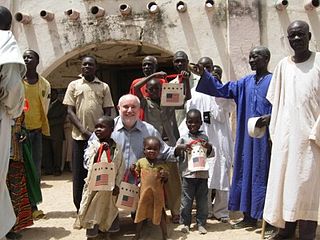
A Senegalese kaftan is a pullover men's robe with long bell sleeves. In the Wolof language, this robe is called a mbubb or xaftaan and in French it is called a boubou. The Senegalese caftan is an ankle length garment. It is worn with matching drawstring pants called tubay in Wolof. Normally made of cotton brocade, lace, or synthetic fabrics, these robes are common throughout West Africa. A kaftan and matching pants is called a kaftan suit. The kaftan suit can be worn with a kufi cap. Senegalese kaftans are formal wear in all West African countries. In the United States, some merchants sell this robe as a Senegalese style dashiki pant set or a full length dashiki pant set. Men who are members of the Hausa tribe, wear these kaftans to formal events like naming ceremonies and weddings. In the United States, a kaftan is one of three formal suits, equivalent to the tuxedo, that African-American grooms select for their weddings. The other styles being the dashiki pant set, and the grand boubou, pronounced gran boo-boo. There are various other formal robes that are worn throughout West Africa, and with the exception of the Yoruba Gbarie robe, pronounced barry, most of these are a form of Islamic dress, see sartorial hijab. The kaftan is worn by Christians, African Jews, Muslims, and followers of African traditional religion. Furthermore, Senegalese kaftans are common among men of African descent in the African diaspora. The Senegalese kaftan is men's attire. In West Africa, and the United States, this robe is not worn by women. The women's robe is called a kaftan.
Combat Dress was the name of the uniform worn by members of Land Force Command of the Canadian Forces from 1968 to 2002.

The Brazilian jiu-jitsu gi is the training uniform adapted from the judo keikogi for use in Brazilian jiu-jitsu. A gi, meaning dress or clothes, is composed of a heavy cotton jacket, reinforced drawstring pants, and a belt which communicates rank. Some schools require the jacket and trousers to be the same color, while more relaxed schools do not enforce matching top and bottom color. The Brazilian jiu-jitsu gi is often referred to as kimono by Brazilians. Some Jiu-Jitsu schools avoid using a gi and instead focus on no-gi jiu-jitsu; 10th Planet Jiu Jitsu is an example of this.

A swim brief or racing brief is any briefs-style male swimsuit such as those worn in competitive swimming, diving and water polo. The popularity of the Australian Speedo brand racing brief has led to the use of its name in many countries around the world to refer to any racing brief, regardless of the maker. Occasionally, the speedo genericized trademark is applied to square cut swimsuits, but in general the generic term is used in reference to swimming briefs. Swim briefs are also referred to as competition briefs, swimming trunks, bathers, togs, racer bathers, posing briefs, racing briefs, and colloquially in Australia, New Zealand, and the United Kingdom as budgie smugglers.
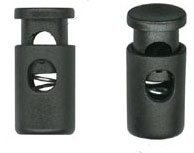
A plastic cord lock attaches to drawstrings and tightens without the use of knots. Cord locks allow mountaineers to fasten clothing and camping equipment quickly in cold conditions when the fingers are encased in heavy gloves. They consist generally of three parts: a barrel, a toggle (plunger), and a spring. Squeezed together, tension is released and the cord lock can move freely up and down the cords. Released, the tension is engaged and the cord lock stays in place. They come in many sizes and shapes to suit to any purpose, including plastic cord lock, mini size cord lock, no spring cord lock, with spring cord lock, with rim cord lock.

The M-1951 field jacket was a U.S. Army four pocket jacket made of 9-ounce wind resistant, water repellent treated cotton sateen cloth in Olive Green Shade 107. It was redesignated as the M-1951 field coat in November 1956.
A pencil suit is a variety of salwar kameez. The suit follows the principles of a pencil skirt and merges it with the traditional salwar kameez.

A drawstring is a string, rope or lace used to "draw" fabric or other material. Ends of a drawstring are often terminated with a sheath called an aglet. The ends may be tied to hold the drawstring in place. Alternatively, it may be kept drawn using a cordlock. Typically, the drawstring is loose when not being used and tightened when needed during use.
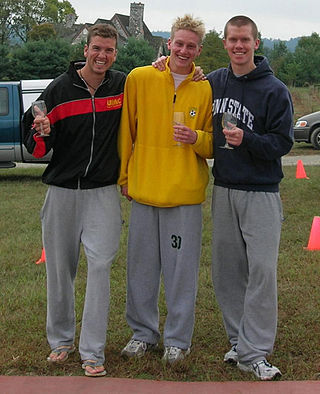
Sweatpants are a casual variety of soft trousers intended for comfort or athletic purposes, although they are now worn in many different situations. In the United Kingdom, Ireland, Australia, New Zealand, and South Africa they are known as tracksuit bottoms or trackies. In Australia and New Zealand, they are also commonly known as trackpants, tracky daks or joggers. They are also referred to as jogging pants in Canada.
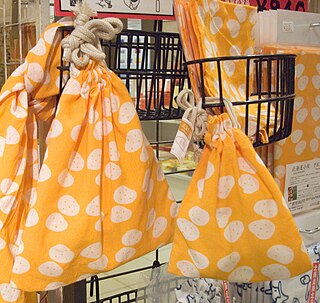
Kinchaku is a traditional Japanese drawstring bag, used like a handbag for carrying around personal possessions; smaller ones are usually used to carry loose coinage, cosmetics, lucky charms, hand warmers and other small items. Larger versions can be used to carry bento and utensils, as well as other larger possessions. The bags traditionally carried by maiko and geisha are a variant on kinchaku, and are called kago (篭) after their woven basket base.

The m/37 helmet is a military steel combat helmet used by Swedish armed forces. Replacing the m/21 helmet, the m/37 would be modernized in 1965 with an updated liner and see use into the 1990s with its replacement by the M1990 Kevlar helmet. Three main variants existed. The first had a three pad liner system, like the m/21 and m/26 before it. The third, most common versions of the modified helmets had the same liner as the pictures but with a canvas chinstrap with a quick-release system. The helmet could be gray, as it always was during the second world war, or painted green as it often, but not always, was during the cold war.